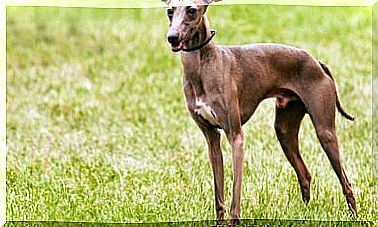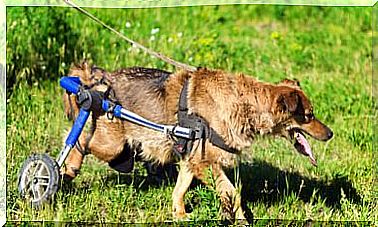Red Fish: Care And Diseases
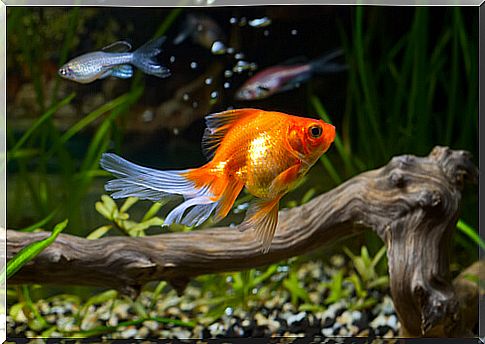
Red fish, also known as goldfish or goldfish, are one of the most popular species in aquariums. Although it is a resistant animal, the red fish needs to receive the appropriate care to preserve its good health.
Most common diseases in red fish
Goldfish are vulnerable to many of the common aquarium fish diseases. Therefore, it is very important to maintain optimal hygiene to prevent these pathologies from threatening the balance of life in our fish tank.
The main diseases that can affect red fish are listed below:
1. Ich’s disease or “white point”
White spot is the popular name for one of the most common diseases in red fish. It is a highly contagious disease caused by the parasite Ichthyophthirius multifiliis, which lives under the skin of fish.
Since these parasites need to leave the fish’s body to reproduce, they form small holes in its skin. In them, cysts form from which new parasites emerge and which tend to become infected quickly.
The most frequent symptoms of this disease in red fish is the appearance of white spots on their skin. As the disease progresses, respiratory problems are also observed due to damage to the gills.
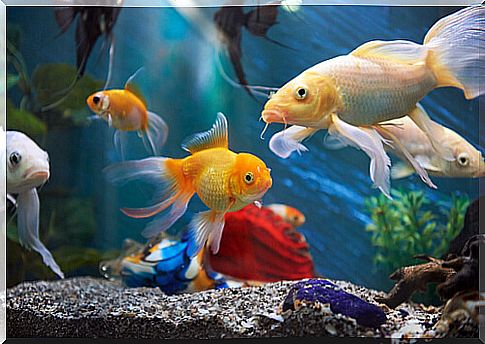
2. Dropsy
It is a chronic disease that usually progresses silently. Drops is related to poor aquarium hygiene, as well as improper maintenance of its filters. However, it can also be caused by a poor diet (nutritional deficiencies).
Symptoms usually only become visible in the later stages of dropsy. In these cases, we observe that the fish swells and that the scales bristle and protrude from its body.
When detecting these symptoms, it will be essential to quarantine infected fish, immediately separating them from healthy animals. Then we will carefully and thoroughly review the hygiene of the aquarium and the quality of the water. It is also recommended to consult a specialized veterinarian about the ideal nutrition for each fish.
3. Leech infestation
Leeches are small and medium-sized ectoparasites that are usually visible to the naked eye. They adhere to the outer layer of the fish’s skin (epidermis) to feed on its blood. In general, they enter the tank when we incorporate new specimens.
The best way to prevent them is to buy fish in stores or reliable and duly approved farms. In addition, it is recommended to check the skin and appearance of the new fish well before incorporating it into the aquarium.
When red fish present some leeches, we can try to remove them carefully. To do this, we will need a small and grippy tweezers, and a clean, fine and damp cloth.
First of all, we will remove the fish from the aquarium and put it on the damp cloth. Then, we will delicately grasp the worm with the forceps, always by the end attached to the skin of the fish. With a single, dry and firm pull, we remove the leech from your skin and disinfect the resulting wound.
Basic care for red fish
In general, red fish need the same care as any other aquarium fish to preserve their good health. They are: an aquarium appropriate to its size and activity, reinforced hygiene, including a good filtering system, optimal water conditions and complete and balanced nutrition.
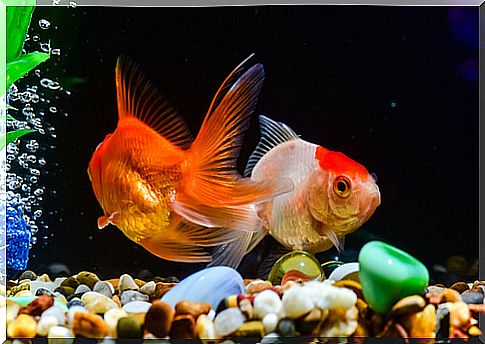
The ideal aquarium for a goldfish
Goldfish are cold-water fish that are best suited to ponds, as they tend to grow quite large. Therefore, to live well in captivity, the golden carp will need to have an aquarium of good dimensions.
It is recommended to purchase a large container, with at least 40 liters for each individual. That is, a pair of red fish would need an aquarium of approximately 80 liters.
After choosing the ideal aquarium for your red fish, it will be time to purchase the most appropriate filter for your model. In stores, we can seek guidance from the vendors themselves.
Water temperature and pH
The red fish live naturally in cold or temperate waters, mostly with temperatures of 15ºC to 20ºC. However, in their wild state, many species can withstand temperatures between 5ºC and 24ºC.
Depending on the temperature of your home and the time of year, it will be essential to consider the need to heat or cool the aquarium water. It is also recommended to regularly measure the pH of your fish tank, always trying to keep it close to pH 7.
Red fish feeding
Red fish are omnivorous animals that enjoy a very varied diet. In nature, it usually consumes crustaceans, insects, plants, larvae, and worms.
In specialized stores, we will find special mixes to feed a goldfish. These preparations are ideal, since they contain the right proportions of all the nutrients.
With a little attention, it is not very difficult to take care of the red fish in our aquarium. The color they will bring to our aquarium and the environment is well worth it.




